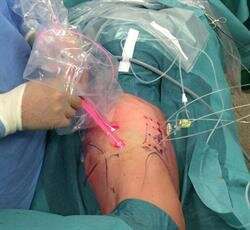Credit: American Society for Laser Medicine and Surgery
A new study reveals the mechanisms whereby low dose photodynamic therapy affects the microstructure of vessels. Using co-cultures of pericytes and endothelial cells in vitro, the authors show that low dose photodynamic therapy activates pericytes through Rho, myosin light chain and focal adhesion kinase phosphorylation (MLC‐P, FAK‐P). This leads to cytoskeletal reconfiguration causing pericytes to contract 3-D collagen gels more efficiently.
The clinical report of this study, published in Lasers in Surgery and Medicine (LSM), the official journal of the American Society for Laser Medicine and Surgery, Inc. (ASLMS), was selected as Editor's Choice in the March 2019 issue of LSM.
The study, led by Jean Yannis Perentes is titled "Vascular‐targeted low dose photodynamic therapy stabilizes tumor vessels by modulating pericyte contractility"
Following these in vitro observations, Perentes and colleagues confirmed their findings in two in vivo models of malignant pleural mesothelioma. They found that low dose Photodynamic therapy caused MLC-P in pericytes which was associated to enhanced pericyte coverage of endothelial cells. This change in microstructure of the vasculature was associated to a drop in tumor interstitial fluid pressure and an enhancement of macromolecule distribution in tumors.
"The modulation of the tumor microenvironment to enhance the distribution and impact of chemotherapy is a promising modality for the management of solid tumors. Our study was performed on mesothelioma xenografts but the field of application could be enhanced to any tumor on which light can be delivered (skin, gut, ears/nose/throat, etc)." said Perentes.
More information: Sabrina Cavin et al. Vascular-targeted low dose photodynamic therapy stabilizes tumor vessels by modulating pericyte contractility, Lasers in Surgery and Medicine (2019). DOI: 10.1002/lsm.23069
Journal information: Lasers in Surgery and Medicine
Provided by American Society for Laser Medicine and Surgery























